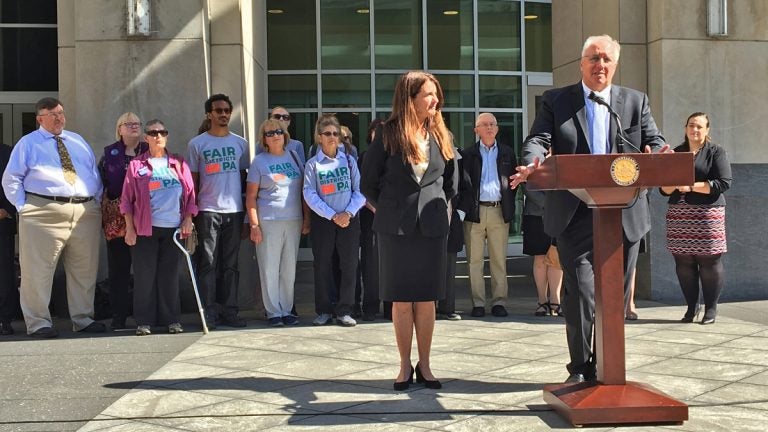Debate over ‘wasted’ votes dominates third day of state redistricting trial

Mimi McKenzie and David Gersch, two of the plaintiffs' lawyers arguing state lawsuit on Pa.'s congressional map, stand outside Commonwealth Court in Harrisburg in October. (Lindsay Lazarski/Keystone Crossroads)
The plaintiffs’ argument in the state lawsuit over Pennsylvania’s congressional district map hinges on whether they can prove the state legislature designed a map meant to dilute Democratic votes.
Much of the trial’s third day was spent by plaintiffs trying to quantify the map’s alleged partisan advantages by looking at decades of data, spurring a debate about how many votes are “wasted” because of the way congressional boundary lines were drawn.
Say you have five congressional districts each with 100 voters. Democrats win two by wide margins, and Republicans win three in tight races.
That’s what redistricting experts would call a map with an “efficiency gap” designed to advantage Republicans by wasting votes for Democrats.
Political scientist Christopher Warshaw testified for the plaintiffs Wednesday that Pennsylvania’s efficiency gap, favoring Republicans, is the currently the widest in the nation.
“The efficiency gap is really capturing the heart of gerrymandering: translating votes into seats with as few votes as possible,” Warshaw said.
He said Pennsylvania’s map gives the GOP a 24 percent efficiency gap edge — the second-widest in decades. The gap in the vast majority of states hovers around 10 percent, he said.
Warshaw testified that the gap in Pennsylvania spiked after the current map took effect in 2011.
The defense, representing GOP leaders in the legislature, pointed out that this gap has narrowed since then, with Democrats gaining back half the ground they lost.
Defense attorney Rob Tucker said competitive races also yield a high number of “wasted votes,” but the map shouldn’t necessarily be faulted if one party happened to lose most or all of them.
Warshaw countered that Pennsylvania has seen relatively few close races recently.
He also showed that Democrats in the state have held efficiency gap advantages in the 1970s and part of the 1990s.
Nationally, he said that Democrats have been slightly advantaged if you look at the gaps over the past 50 years as a whole – evidence that both parties gerrymander when they can.
That point was supported by his finding that, across the country, efficiency gaps shifted in 2012 in favor of the majority party in the legislature in states where lawmakers control redistricting, which occurs after each U.S. Census.
He also tied big efficiency gaps — regardless of partisan advantage — to political mistrust. He pointed to polling data that shows constituents in states with wider gaps advantaging a party different from theirs are less likely to trust their representative and agree with their positions.
The plaintiffs in the case consist of one Democratic voter from each of the state’s 18 Congressional districts. Republicans controlled all three branches of state government during the last two rounds of redistricting. The current map, though, did garner significant support from Democrats in the state legislature, seemingly as a way to support congressional incumbents who were given safer districts.
Proceedings in the trial are expected to continue Thursday and Friday, when the defense’s witnesses will testify.
WHYY is your source for fact-based, in-depth journalism and information. As a nonprofit organization, we rely on financial support from readers like you. Please give today.






